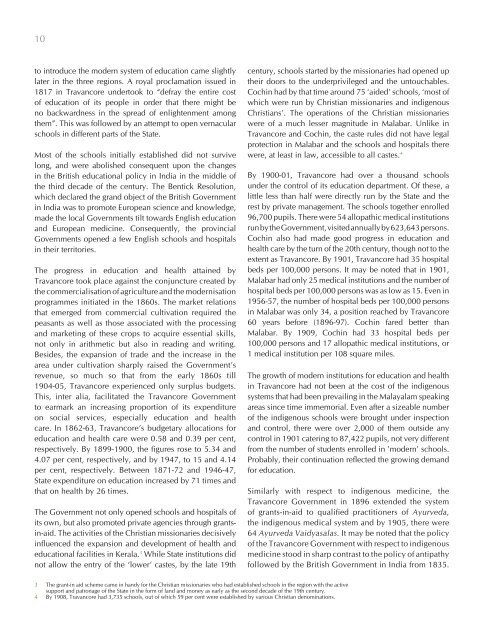Kerala 2005 - of Planning Commission
Kerala 2005 - of Planning Commission
Kerala 2005 - of Planning Commission
You also want an ePaper? Increase the reach of your titles
YUMPU automatically turns print PDFs into web optimized ePapers that Google loves.
10<br />
to introduce the modern system <strong>of</strong> education came slightly<br />
later in the three regions. A royal proclamation issued in<br />
1817 in Travancore undertook to “defray the entire cost<br />
<strong>of</strong> education <strong>of</strong> its people in order that there might be<br />
no backwardness in the spread <strong>of</strong> enlightenment among<br />
them”. This was followed by an attempt to open vernacular<br />
schools in different parts <strong>of</strong> the State.<br />
Most <strong>of</strong> the schools initially established did not survive<br />
long, and were abolished consequent upon the changes<br />
in the British educational policy in India in the middle <strong>of</strong><br />
the third decade <strong>of</strong> the century. The Bentick Resolution,<br />
which declared the grand object <strong>of</strong> the British Government<br />
in India was to promote European science and knowledge,<br />
made the local Governments tilt towards English education<br />
and European medicine. Consequently, the provincial<br />
Governments opened a few English schools and hospitals<br />
in their territories.<br />
The progress in education and health attained by<br />
Travancore took place against the conjuncture created by<br />
the commercialisation <strong>of</strong> agriculture and the modernisation<br />
programmes initiated in the 1860s. The market relations<br />
that emerged from commercial cultivation required the<br />
peasants as well as those associated with the processing<br />
and marketing <strong>of</strong> these crops to acquire essential skills,<br />
not only in arithmetic but also in reading and writing.<br />
Besides, the expansion <strong>of</strong> trade and the increase in the<br />
area under cultivation sharply raised the Government’s<br />
revenue, so much so that from the early 1860s till<br />
1904-05, Travancore experienced only surplus budgets.<br />
This, inter alia, facilitated the Travancore Government<br />
to earmark an increasing proportion <strong>of</strong> its expenditure<br />
on social services, especially education and health<br />
care. In 1862-63, Travancore’s budgetary allocations for<br />
education and health care were 0.58 and 0.39 per cent,<br />
respectively. By 1899-1900, the figures rose to 5.34 and<br />
4.07 per cent, respectively, and by 1947, to 15 and 4.14<br />
per cent, respectively. Between 1871-72 and 1946-47,<br />
State expenditure on education increased by 71 times and<br />
that on health by 26 times.<br />
The Government not only opened schools and hospitals <strong>of</strong><br />
its own, but also promoted private agencies through grantsin-aid.<br />
The activities <strong>of</strong> the Christian missionaries decisively<br />
influenced the expansion and development <strong>of</strong> health and<br />
educational facilities in <strong>Kerala</strong>. 3 While State institutions did<br />
not allow the entry <strong>of</strong> the ‘lower’ castes, by the late 19th<br />
century, schools started by the missionaries had opened up<br />
their doors to the underprivileged and the untouchables.<br />
Cochin had by that time around 75 ‘aided’ schools, ‘most <strong>of</strong><br />
which were run by Christian missionaries and indigenous<br />
Christians’. The operations <strong>of</strong> the Christian missionaries<br />
were <strong>of</strong> a much lesser magnitude in Malabar. Unlike in<br />
Travancore and Cochin, the caste rules did not have legal<br />
protection in Malabar and the schools and hospitals there<br />
were, at least in law, accessible to all castes. 4<br />
By 1900-01, Travancore had over a thousand schools<br />
under the control <strong>of</strong> its education department. Of these, a<br />
little less than half were directly run by the State and the<br />
rest by private management. The schools together enrolled<br />
96,700 pupils. There were 54 allopathic medical institutions<br />
run by the Government, visited annually by 623,643 persons.<br />
Cochin also had made good progress in education and<br />
health care by the turn <strong>of</strong> the 20th century, though not to the<br />
extent as Travancore. By 1901, Travancore had 35 hospital<br />
beds per 100,000 persons. It may be noted that in 1901,<br />
Malabar had only 25 medical institutions and the number <strong>of</strong><br />
hospital beds per 100,000 persons was as low as 15. Even in<br />
1956-57, the number <strong>of</strong> hospital beds per 100,000 persons<br />
in Malabar was only 34, a position reached by Travancore<br />
60 years before (1896-97). Cochin fared better than<br />
Malabar. By 1909, Cochin had 33 hospital beds per<br />
100,000 persons and 17 allopathic medical institutions, or<br />
1 medical institution per 108 square miles.<br />
The growth <strong>of</strong> modern institutions for education and health<br />
in Travancore had not been at the cost <strong>of</strong> the indigenous<br />
systems that had been prevailing in the Malayalam speaking<br />
areas since time immemorial. Even after a sizeable number<br />
<strong>of</strong> the indigenous schools were brought under inspection<br />
and control, there were over 2,000 <strong>of</strong> them outside any<br />
control in 1901 catering to 87,422 pupils, not very different<br />
from the number <strong>of</strong> students enrolled in 'modern' schools.<br />
Probably, their continuation reflected the growing demand<br />
for education.<br />
Similarly with respect to indigenous medicine, the<br />
Travancore Government in 1896 extended the system<br />
<strong>of</strong> grants-in-aid to qualified practitioners <strong>of</strong> Ayurveda,<br />
the indigenous medical system and by 1905, there were<br />
64 Ayurveda Vaidyasalas. It may be noted that the policy<br />
<strong>of</strong> the Travancore Government with respect to indigenous<br />
medicine stood in sharp contrast to the policy <strong>of</strong> antipathy<br />
followed by the British Government in India from 1835.<br />
3 The grant-in aid scheme came in handy for the Christian missionaries who had established schools in the region with the active<br />
support and patronage <strong>of</strong> the State in the form <strong>of</strong> land and money as early as the second decade <strong>of</strong> the 19th century.<br />
4 By 1908, Travancore had 3,735 schools, out <strong>of</strong> which 59 per cent were established by various Christian denominations.

















